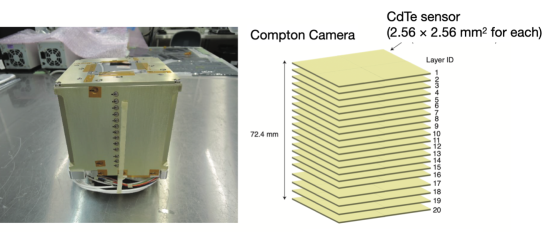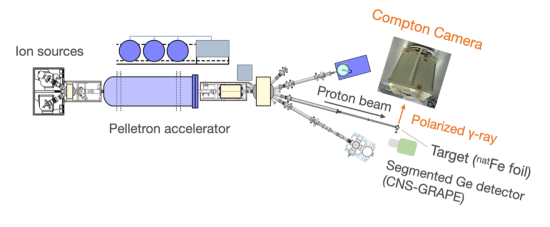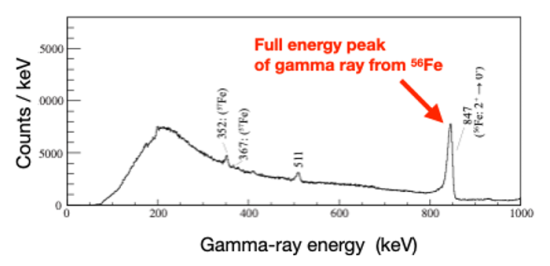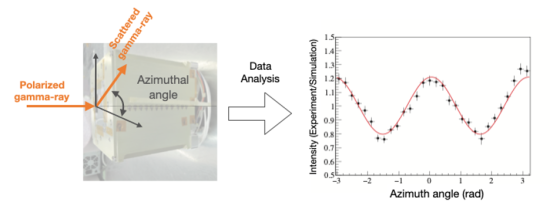February 9, 2024
RIKEN
Kavli Institute for the Physics and Mathematics of the Universe (Kavli IPMU, WPI)

A group of researchers have used equipment originally intended for astronomy observation to capture transformations in the nuclear structure of atomic nuclei, reports a new study in Scientific Reports.
A nucleus is made up of protons and neutrons. About 270 stable nuclei exist in nature, but this number bounces up to 3000 if you include unstable nuclei. Recent research on unstable nuclei has uncovered phenomena not observed in stable nuclei, including anomalies in energy levels, the disappearance of magic numbers, and the emergence of new magic numbers.
To study these structural changes, it is important to determine the quantum states, internal energy, spin, and parity of the state. Conventional methods have been limited by the difficulty of balancing sensitivity and detection efficiency when analyzing electromagnetic characteristics of transitions.
Now researchers including including Kavli Institute for the Physics and Mathematics of the Universe (Kavli IPMU, WPI) Professor Tadayuki Takahashi and and graduate student (at the time of research) Yutaka Tsuzuki, along with RIKEN Cluster for Pioneering Research Ueno Nuclear Spectroscopy Laboratory researchers Shintaro Go and Hideki Ueno, RIKEN Nishina Center for Accelerator-Based Science Cosmic Radiation Laboratory Hiroki Yoneda, Kyushu University Associate Professor Yuichi Ichikawa, and Tokyo City University Associate Professor Tatsuki Nishimura, have utilized their multi-layer semiconductor Compton camera to capture the polarization of gamma rays emitted from atomic nuclei. This reveals the internal structure of the atomic nuclei.
This method significantly reduces uncertainties in determining spin and parity for quantum states in rare atomic nuclei, making it possible to capture transformations in nuclear structure.
The Compton camera includes a Cadmium Telluride (CdTe) semiconductor imaging sensor, which was originally designed for astronomy observation. It has a high detection efficiency and precise position determination accuracy. The research group used this camera in nuclear spectroscopy experiments with controlling both the position and intensity of gamma-rays emissions from the target artificially, allowing for a detailed analysis of scattering events and realizing a highly sensitive polarization measurement.

The researchers capitalized on of the positional accuracy of pixel-type imaging sensor, and used accelerator experiments at the RIKEN Pelletron accelerator to evaluate the camera's performance. Proton beams were directed at a thin iron film target, generating the first excited state of 56Fe nuclei. The emitted gamma rays were measured, revealing a peak structure.


The team succeeded to extract the distribution of scattering azimuth angle. The remarkably high sensitivity to capture the polarization of gamma ray was obtained with reliable detection efficiency. This performance is crucial for investigating the structure of rare radioactive nuclei.
This research could pave the way for a more profound comprehension of the fundamental principles underlying the formation of the universe and the characteristics of matter, including the disintegration process of magic numbers in exotic, unstable nuclei.
Details of their study were published in Scientific Reports on February 9.
Paper details
Journal: Scientific Reports
Paper title: Demonstration of nuclear gamma-ray polarimetry based on a multi-layer CdTe Compton Camera
Authors: S. Go, Y. Tsuzuki, H. Yoneda, Y. Ichikawa, T. Ikeda, N. Imai, K. Imamura, M.Niikura, D. Nishimura, R. Mizuno, S. Takeda, H. Ueno, S. Watanabe, T. Y. Saito, S. Shimoura, S. Sugawara, A. Takamine, and T. Takahashi
DOI: doi.org/10.1038/s41598-024-52692-2 (published 9 Feb 2024)
Enquiries
Motoko Kakubayashi
Press officer
Kavli Institute for the Physics and Mathematics of the Universe (Kavli IPMU)
The University of Tokyo
E-mail:press_at_ipmu.jp
* Please change _at_ to @
Related links
Takahashi Laboratory website (in Japanese)
Toward new frontiers : Encounter and synergy of state-of-the-art astronomical detectors and exotic quantum beams
